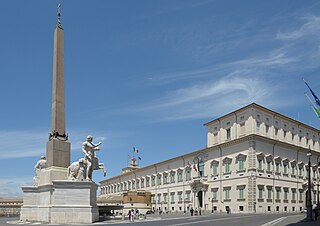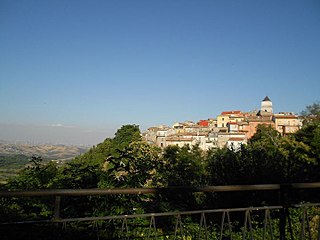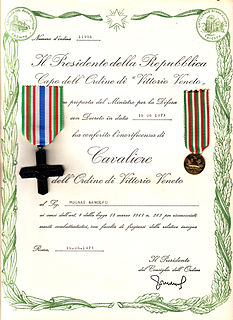Related Research Articles

The Italian Armed Forces encompass the Italian Army, the Italian Navy and the Italian Air Force. A fourth branch of the armed forces, known as the Carabinieri, take on the role as the nation's military police and are also involved in missions and operations abroad as a combat force. Despite not being a branch of the armed forces, the Guardia di Finanza has military status and is organized along military lines. These five forces comprise a total of 340,885 men and women with the official status of active military personnel, of which 167,057 are in the Army, Navy and Air Force. The President of the Italian Republic heads the armed forces as the President of the High Council of Defence established by article 87 of the Constitution of Italy. According to article 78, the Parliament has the authority to declare a state of war and vest the powers to lead the war in the Government.

The Quirinal Palace is a historic building in Rome, Italy, one of the three current official residences of the President of the Italian Republic, together with Villa Rosebery in Naples and the Tenuta di Castelporziano, an estate on the outskirts of Rome, some 25 km from the centre of the city. It is located on the Quirinal Hill, the highest of the seven hills of Rome in an area colloquially called Monte Cavallo. It has served as the residence for thirty Popes, four Kings of Italy and twelve Presidents of the Italian Republic.

The Civil Guard is the oldest law enforcement agency in Spain and is one of two national police forces. As a national gendarmerie force, it is military in nature and is responsible for civil policing under the authority of both the Ministry of the Interior and the Ministry of Defence. The role of the Ministry of Defence is limited except in times of war when the Ministry has exclusive authority. The corps is colloquially known as the benemérita (reputable). In annual surveys, it generally ranks as the national institution most valued by Spaniards, closely followed by other law enforcement agencies and the armed forces.

The Pantheon is a former Roman temple and, since 609 AD, a Catholic church in Rome, Italy, on the site of an earlier temple commissioned by Marcus Agrippa during the reign of Augustus. It was rebuilt by the emperor Hadrian and probably dedicated c. 126 AD. Its date of construction is uncertain, because Hadrian chose not to inscribe the new temple but rather to retain the inscription of Agrippa's older temple, which had burned down.

Guard mounting, changing the guard, or the changing of the guard, is a formal ceremony in which sentries performing ceremonial guard duties at important institutions are relieved by a new batch of sentries. The ceremonies are often elaborate and precisely choreographed. They originated with peacetime and battlefield military drills introduced to enhance unit cohesion and effectiveness in the late 17th and early 18th centuries.

The Tomb of the Unknown Soldier is a tomb situated before the National War Memorial in Confederation Square, Ottawa, Ontario. The tomb is dedicated to Canadian service members, and holds the remains of an unidentified Canadian soldier who died in France during the First World War; selected from a Commonwealth War Grave near Vimy, in the vicinity where the Battle of Vimy Ridge took place.

The Victor Emmanuel II National Monument, also known as Vittoriano or Altare della Patria, is a large national monument built between 1885 and 1935 to honour Victor Emmanuel II, the first king of a unified Italy, in Rome, Italy. It occupies a site between the Piazza Venezia and the Capitoline Hill. The monument was realized by Giuseppe Sacconi.

The Cuirassiers Regiment is a Carabinieri cavalry regiment acting as guard of honour of the President of the Italian Republic. Their motto is Virtus in periculis firmior.

The Corps of the Port Captaincies – Coast Guard is the coast guard of Italy and is part of the Italian Navy under the control of the Ministry of Infrastructure and Transport. Its head office is in Rome.

A guard of honour (GB), also honor guard (US), also ceremonial guard, is a group of people, usually military in nature, appointed to receive or guard a head of state or other dignitaries, the fallen in war, or to attend at state ceremonials, especially funerals. In military weddings, especially those of commissioned officers, a guard, composed usually of service members of the same branch, form the Saber arch. In principle any military unit could act as a guard of honour. However, in some countries certain units are specially designated to serve as a guard of honour, as well as other public duties.

Guardia Lombardi, known as La Uàrdia in the Irpinian dialect, is a small town and comune in the Province of Avellino in Campania, Italy. At an elevation of 998 metres (3,274 ft), it is located in Irpinia in the Apennine Mountains of Southern Italy. It has experienced a number of major earthquakes throughout its history that have devastated the town, and is considered within zone 1 of the Protezione Civile's seismic classification index, indicating very high seismicity.

The Basilica of Superga is a church in Superga, in the vicinity of Turin.

Elisabeth of Swabia, was a member of the House of Hohenstaufen who became Queen of Castile and Leon by marriage to Ferdinand III.

The Pontifical Swiss Guard is a minor armed force and honour guard unit maintained by the Holy See that protects the pope and the Apostolic Palace within the territory of the Vatican City. Established in 1506 under Pope Julius II, the Pontifical Swiss Guard is among the oldest military units in continuous operation.

Festa della Repubblica is the Italian National Day and Republic Day, which is celebrated on 2 June each year, with the main celebration taking place in Rome. The Festa della Repubblica is one of the national symbols of Italy.
The Medal of Military Valor is an Italian medal, originally established as a Sardinian award. It is awarded to military personnel, units above the level of company, and civilians for exceptional valor in the face of the enemy.

The Pantheon of the House of Braganza, also known as the Pantheon of the Braganzas, is the final resting place for many of the members of the House of Braganza, located in the Monastery of São Vicente de Fora in the Alfama district of Lisbon, Portugal. The pantheon's burials have included Portuguese monarchs, Brazilian monarchs, a Romanian monarch, queen consorts of Portugal, and notable Infantes of Portugal, among others.

The Italian honours system is a means to reward achievements or service to the Italian Republic, formerly the Kingdom of Italy including the Italian Social Republic.

The Guardia di Finanza is an Italian law enforcement agency under the authority of the Minister of Economy and Finance. It is a militarized police force, forming a part of the Ministry of Economy and Finance, not the Ministry of Defence. Guardia di Finanza is essentially responsible for dealing with financial crime and smuggling; it has also evolved into Italy's primary agency for suppressing the illegal drug trade. It maintains over 600 boats and ships and more than 100 aircraft to serve in its mission of patrolling Italy's territorial waters. They also have the role of border police and customs duties at Italian airports.

The Tomb of the Unknown Soldier is a war memorial located in Rome under the statue of the goddess Roma at the Altare della Patria. It is a sacellum dedicated to the Italian soldiers killed and missing during war.
References
- 1 2 "Legislatura 14 Atto di Sindacato Ispettivo n° 4-08615". Senato della Republica (in Italian). Senate of Italy . Retrieved December 29, 2017.
- 1 2 3 Povoledo, Elisabetta (August 11, 2014). "Standing Guard Over a Monarchy's Tainted Legacy". New York Times . Retrieved December 29, 2017.
- 1 2 "Iscrizioni". guardiadonorealpantheon.it (in Italian). Guardia d'Ono del Pantheon. Retrieved December 29, 2017.